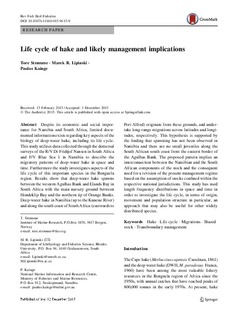| dc.description.abstract | Despite its economic and social importance for Namibia and South Africa, limited documented information exists regarding key aspects of the biology of deep-water hake, including its life cycle. This study utilizes data collected through the demersal surveys of the R/V Dr Fridtjof Nansen in South Africa and F/V Blue Sea 1 in Namibia to describe the migratory patterns of deep-water hake in space and time. Furthermore the study investigates aspects of the life cycle of this important species in the Benguela region. Results show that deep-water hake spawns between the western Agulhas Bank and Elands Bay in South Africa with the main nursery ground between Hondeklip Bay and the northern tip of Orange Banks. Deep-water hake in Namibia (up to the Kunene River) and along the south coast of South Africa (eastwards to Port Alfred) originate from these grounds, and undertake long-range migrations across latitudes and longitudes, respectively. This hypothesis is supported by the finding that spawning has not been observed in Namibia and there are no small juveniles along the South African south coast from the eastern border of the Agulhas Bank. The proposed pattern implies an interconnection between the Namibian and the South African components of the stock and the consequent need for a revision of the present management regime based on the assumption of stocks confined within the respective national jurisdictions. This study has used length frequency distributions in space and time in order to investigate the life cycle, in terms of origin, movement and population structure in particular, an approach that may also be useful for other widely distributed species. | nb_NO |
